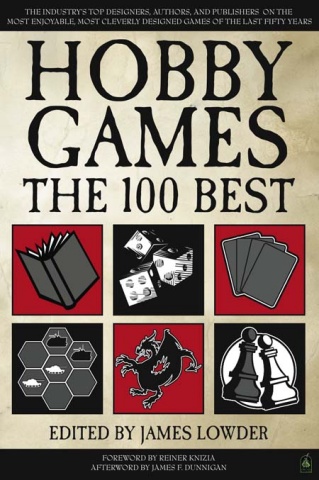
Arrived yesterday. Edited by James Lowder (Green Ronin, 2007), it’s surprising no one’s done this before: ask prominent game designers to write about their favorite games. So you get Richard Garfield on Dungeons and Dragons and Gary Gygax (RIP) on Metamorphosis Alpha, Steve Jackson on Paranoia and Erick Wujcik on OGRE. Collectible Card Games, RPGs, Euros, and wargames are all represented, even some miniatures. Wargame titles include Thomas M. Reid on Axis and Allies, Tracy Hickman on Battle Cry, Skip Williams on Dawn Patrol, Alessio Cavatore on Empires in Arms, William Jones on Flames of War, Lou Zocchi on Gettysburg, Gav Thorpe on Hammer of the Scots, Uli Blennemann on Here I Stand, Craig Taylor on A House Divided, Dana Lombardy on Johnny Reb, Ted Raicer on London’s Burning, Chris Klug on Napoleon’s Last Battles, John Scott Tynes on Naval War, Mike Bennighoff on PanzerBlitz, Joseph Miranda on Renaissance of Infantry, Ray Winninger on Squad Leader, Lewis Pulsipher on Stalingrad, Douglas Niles on Terrible Swift Sword, Zev Shlasingle on Twilight Struggle, Sandy Peterson on Up Front, and R. A. Salvatore on War and Peace. Each entry is about three pages long, and, in a nice touch, they’re presented alphabetically by game, making it easy to look up titles.
Other writes include Richard Berg (on Plague!) and Ed Greenwood (on Thurn and Taxis); but no Richard Borg, Mark Herman, John Hill, or Charles Roberts. There’s also an afterword from Jim Dunnigan (it says little if anything new). It’s nice to see some very contemporary games like Here I Stand and Flames of War in there along with the old chestnuts. I frankly was expected a lot of puff pieces, but overall the quality of the writing is high. Here’s Winninger on Squad Leader for example:
Avalon Hill built its reputation in the 1960s with elegant wargames that asked players to route Ney off the Quatre Bras heights, to encircle Tobruk with Montgomery’s 8th Army, or to stave off Army Group Center’s advance on Moscow. When it exploded onto the scene in 1977, John Hill’s Squad Leader presented armchair generals with a new and unusual challenge—crossing a street. (288)
And a few lines later, “Thanks to John Wayne and Lee Marvin, it was relatively easy for gamers to translate the action of the game board into ‘real’ battles in their imaginations, lending the whole experience a lively, escapist quality. (By contrast, try to imagine exactly what a ‘2-to-1 attack’ on Leningrad looks like)” (288-9).
Exactly right. And here’s Jeff Tidball on Car Wars:
From the first release of the first edition, players were empowered to create and arm their vehicles from the ground up, and they had lots of options. They were free to obsess over such minutiae as the weight and cost of the individual rounds with which their recoilless rifles were loaded. And not for nothing: trading a bit of ammo for a point or three of armor could spell the difference between life or death in the arena! By the time the various—and definitive—boxed Deluxe Editions were released in the mid-’80s to early ’90s, the game burst with options, from flaming oil slicks to tank guns, to laser-reactive webs to fake passengers.
Such deep but structured creative opportunities—long before collectible card games made “customizable” a design buzzword—gave Car Wars the effectively solo game play mode of vehicle creation, and also a mode of “extroverted” metaplay—the sharing of car designs, fan to fan, via Autoduel Quarterly, club news letters, and, later, the Web. (50)
Really excellent, that. Recommended.


